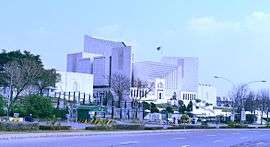History of the Supreme Court of Pakistan

The History of the Supreme Court of Pakistan, organized by the Chief Justice of Pakistan, follows from its constitutional establishment in 1947 till its recent events. The Supreme Court of Pakistan is the highest appellate court of the country and court of last resort— the final arbiter of the law and the Constitution.[1]
Having established in 1948 as the Federal Court, the Supreme Court's constitutional restructure and recreation was reviewed by the 1956 articles; it has retained its name and jurisdiction through the successive legal instruments since 1973 convention.[2] The Supreme Court enjoys the constitutional and jurisdictional supremacy over any court in the Court system of the country where it exercises original, appellate and review jurisdiction.[3] It possesses exclusive original jurisdiction for the settlement of intergovernmental disputes between federal and provisional governments and high courts Inter se.[3] Since Pakistan's establishment in 1947, the Supreme Court has played a prominent role in country's events, and its decisions ultimately deciding the fate of the country.[4]
Transient period
Early years (1947–1960)
Upon the establishment of Pakistan, the Founder of Pakistan and Governor-General approved the appointment of Sir Abdul Rashid as the nation's first Chief Justice in 1948.[5] Justice Sir Rashid was succeeded by Justice Muhammad Munir in 1954. Perhaps, the most controversial case of at that time was the Maulvi Tamizuddin Khan vs. the Governor-General, in which the Supreme Court solidified the "Doctrine of necessity" by well quoted by Chief Justice Munir: Relying on the Bracton's maxim, that which is otherwise not lawful is made lawful by necessity', thereby providing the label that would come to be attached to the judgment and the doctrine that it was establishing."[6]
Another major case that was heard by the Supreme Court bench led by Chief Justice Muhammad Shahabuddin was on 7 October 1958.[7] The Chief Justice Shahabuddin bench heard the "The State vs. Dosso & anor.", under which the majority of Chief Justice Shahabuddin bench provided the legal validation of the martial law imposed by President of Pakistan Iskander Mirza.[7] In further, President Mirza was dismissed in two weeks by Chief of Army Staff General Ayub Khan whose actions was also to be held valid by Chief Justice Shahabuddin's court.[7]
Historical resources
- ↑ Article 184(1)–191 in VII: The Judicature– Chapter 2: The Supreme Court of Pakistan of the Constitution of Pakistan.
- ↑ Articles 175(1)–212(B) in the Part VII: The Judicature of the Constitution of Pakistan
- 1 2 et. al., staff writers,. "History". Supreme Court of Pakistan (Public domain). Supreme Court of Pakistan Press, History. Retrieved 28 June 2014.
- ↑ Misra, edited by Ashutosh; Clarke, Michael E. (2012). Pakistan's stability paradox domestic, regional, and international dimensions. Milton Park, Abingdon, Oxon [England]: Routledge, 2012. ISBN 1136639349. Retrieved 28 June 2014.
- ↑ et. al., staff reporter/writer (September 5, 2005). "Road in capital being named after Justice Sir Abdul Rashid". Dawn Newspapers, 2005. Retrieved 28 June 2014.
- ↑ Amita Shastri, A. Jeyaratnam Wilson, The post-colonial states of South Asia: democracy, development, and identity, Palgrave Macmillan, 2001, ISBN 978-0-312-23852-0,
... Dismissing Mirza, army chief General Mohammad Ayub Khan took over first as chief martial law administrator ... a compliant judiciary upheld the imposition of martial law under the doctrine of necessity ...
- 1 2 3 edited, T.O. Elias ;; Akinjide, revised by Richard (1988). Africa and the development of international law (2nd rev. ed.). Dordrecht: M. Nijhoff. ISBN 9024737966. Retrieved 28 June 2014.